Originally Published in the New Zealand Slavonic Journal, 2000
Women as Princesses or Comrades: Ambivalence in Yakov Protazanov’s Aelita (1924)
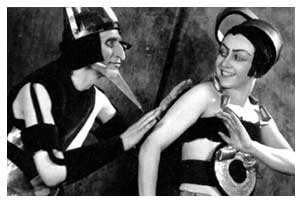
The Civil War has ended. A widowed Russian engineer goes to Mars with a demobilised Red Army officer and falls in love with a Martian princess. Her ancestors are of mixed descent, some having come from Earth, from Atlantis, in fact, so she is almost human. A workers’ revolt begun by a Martian engineer forces the couple to flee to a cave. The Russian hero tries to commit a double love suicide with her, but she alone drinks enough from the poisoned cup to die. He returns to earth, but hears her voice calling for him across time and space.
The Civil War has ended. A Russian engineer grows suspicious that his wife is betraying him and shoots a gun off at her. He goes to Mars with a detective and a demobilised Red Army officer. On the Red Planet the princess has already fallen in love with him by watching him through a telescope. He finds himself in the middle of a proletarian revolution led by the Red Army man, which the princess has tried to defuse by declaring herself a leader of the uprising. He starts confusing her with his dead spouse, only to awaken and find that he is really on earth where his uninjured and all-forgiving wife cradles him like a surrogate mother.
The first plot is the outline of Alexei N Tolstoy’s (1883–1945) science fiction novel. Aelita: Zakat Marsa (Aelita: The Sunset of Mars), serialised in Krasnaia Nov´ (Red Soil) No 6 (1922) and No 2 (1923), published in Moscow/Petrograd by Giz and in Berlin by Ladyzhnikov in 1923, and after some revisions collected in his eleven-volume complete works in 1958. The second plot is that of the film adaptation of this novel directed by Yakov Protazanov (1881–1945) and released by the Mezhrabpom-Russ studio on 25 September 1924. Both the novel and its adaptation met the ire of many Soviet reviewers, who seemed no more inclined to accept the character of the Martian princess Aelita as the projection of Engineer Los’s erotic fantasies than as his extraterrestrial beloved. The novel was adapted so that Aelita tries to lead the counter-revolution in the Mars plot, has no existence outside of the engineer’s mind in the framing plot, and loses Los to the wife that he has tried to kill in the symbolic plot. Why were these changes seen as potential improvements in a novel that had been promoted as a work of major literary importance in the leading literary periodical of the day?
The answer must be sought in the tensions at work in Soviet society in the period immediately after Lenin’s death in January 1924. The film dramatises in a clearer way than the novel the questions facing Soviet society on the role of cultural revolution in violent revolutionary change, the status in Soviet society of the bourgeois technical expert educated before the Revolution, and the question of feminism as a viable movement within Marxism. Protazanov’s Aelita represents an attempt to assert a pro-Lenin, anti-Bogdanov stance that revolution must precede cultural change rather than stem from it, discredits the character of the bourgeois engineering class, and limits feminism to the public world of work rather than extending it to the home environment.
Before turning to these issues, we must provide background on the reception history of the film and point out the wide variety of responses and interpretations it has generated. By and large Aelita has been noted as a deviation from Soviet film practice. In the West Aelita was the most celebrated Soviet film before Potemkin (Leyda 186), mostly because of its Constructivist costumes by the distinguished artist Alexandra Exter, the Martian objects made in the new material of plexiglass by Isaac Rabinovitch (Tsikounas 91), and the overall plan of the set designs by Sergei Kozlovsky (who was later to work for Vsevolod Pudovkin on his three major silent films). For some critics, such as Denise Youngblood, only the costumes and sets are impressive. However, another critic, Paul Schmidt in ‘Constructivism and Film’ trashes Aelita to promote Eisenstein and Vertov as the true Constructivists in film (283). A third critic, Miriam Tsikounas, points out that other films of the period little known in the West also have striking modernist sets, such as Viktor Egorov’s designs for the Rockefeller laboratory in Mezhrabpom-Russ’s Miss Mend (1992: 90–91). Our usual understanding of Aelita’s modernism is unfortunately probably predicated on the fact that the canon of Soviet film of the 1920s is still basically only those films which were well received in the West during that period. These are the two dozen films that are easily accessible on videotape out of the hundreds made in the 1920s.
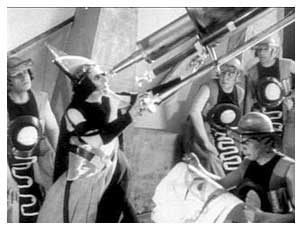
In an article of 1983, the author analysed Aelita in terms of the use of the gaze, which is associated with Engineer Los’s imagining himself watched on Earth by Aelita on Mars. The film’s great psychological complexity had hitherto been overlooked because of critics’ unhealthy separation of Russian film from Western European film. We should heed Kristin Thomson, who writes that it is important to think of Soviet cinema of the 1920s as an international cinema because of its extensive dependence on foreign trade and credit, especially IAH (Internationale Arbeitshilfe). In 1923, IAH set up a joint production and distribution company with the private Russian cooperative firm Russ. It initially owned 50% of the company but gradually took over Russ’s share by 1928 (Thompson 30). Up to 1931, 34% of the films made by Mezhrabpom-Russ were exported and they made 918,326.74 rubles of 20,306,468.65 rubles abroad (38). In fact, Mezhrabpom-Russ films were too Western in orientation for many Bolshevik critics, and the company was accused of making films, including Aelita, deliberately for export to gain money from Western audiences. [1]
The question of Aelita’s ideological conformity has been a vexing one, and there has been no agreement about its political implications. In 1979 Richard Taylor (74) wrote that Aelita “combined ideological rectitude with a strong streak of experimentation.” A year later in The Phenomenon of the Soviet Cinema, published in Moscow by Progress Publishers, a book with a noticeable propaganda streak, Yuri Vorontosv and Igor Rachuk also suggest that the film was ideologically acceptable, claiming that the film presented only a conventional Mars, whereas the “scenes of ordinary daily life were realistic and had a ring of truth to them” (60).
In strong contrast, in 1992 Peter Kenez noted that Aelita was attacked for showing the young Soviet Union in an overly critical fashion. A person was “not supposed to wish to escape from Communist Russia—even as a joke” (46). In fact, Kenez remarks, the film was considered so critical of contemporary life by some of the authorities that it was not shown to peasant audiences (92). Yet Kenez suspects that the fact that Earth was so drab in the film that even a fantasy Mars was alluring constitutes one of the reasons for its being on the list of Soviet forbidden films for 1936. In fact, according to Ian Christie (1993:147), the film had been withdrawn from distribution within the Soviet Union in the early 1930s. When the first state awards for film were issued in 1935, Protazanov (with Eisenstein and Kuleshov) was named only an Honoured Art Worker, below the Order of Lenin, Red Banner of Labour, and People’s Artist (Christie 55) because Aelita and other films of his had been withdrawn.
Denise Youngblood has done the most extensive research on the mixed reception on the first release of Aelita. In an unusually florid publicity campaign the film was promoted with advertising leaflets dropped from airplanes. The crew of 3,000 workers and the 22,200 meters of film footage shot were touted as assets to the add campaign, but later these figures came to signify extravagant waste. The charge of commercialism aimed at the film was also directed at Mezhrabpom-Russ. Protazanov was held up as either a fellow traveller or as a technician hanging on from before the Revolution, although he was a talented director who had returned from four years of exile in Paris and Berlin specifically to direct this film. One critic, Vladimir Erofeev claimed that Russia did not need philistine dreams about a bourgeois Mars, and another, Nikolai Lebedev, accused the film of destroying the ideological significance of the novel. The film was also accused of stripping the proletarian revolution of Mars of its ideological value through its use of the dream (Youngblood 1992:109). Nevertheless, Cinema Gazette printed large ads from Aelita, and both Pravda and Red Star gave it favorable reviews (Youngblood 1985:30–32).
Did Protazanov’s film sacrifice its ideological value through its frame narrative? Dmitry and Vladimir Shlapentokh in Soviet Cinematography: Ideological Conflict and Social Reality, 1918–1991 claim that it did not. Like films such as Pudovkin’s The End of Saint Petersburg (1927), Aelita gives the message that the masses never have understood their historical mission as their own (53). They feel that Aelita centres on a passive Martian populace that needs the help of Gusev, a Bolshevik who comes from Earth, in order to undertake an uprising (54). Such an interpretation of the film would be seen as fitting in well with a Bolshevik government that never went through with its 1917 slogan of all power to the soviets.
The Shlapentokhs’ interpretation implies stressing the Mars plot over the frame of the dream-fantasy plot. In contrast, Kenez suggests, as does Youngblood (1985:31–32) that priority should be given to the framing plot, but even here the mise-en-scene may prompt the audience to resist the idea that although dreams are fun, the real work for Soviet citizens lies ahead on Earth not Mars (31–32). Yet neither of these lines of interpretation addresses the question of allegory or Aesopic fiction, in this case, whether Mars should be considered as a stand-in for Russia. If we do take the Martian uprising and Aelita’s attempt to commandeer it symbolically, we are forced to confront another potential message of the film—one which may or may not have been intended as a subtext—that political revolution without cultural revolution will lead to the defeat of socialism, the fear expressed by the anti-Leninist Bolshevik Alexander Bogdanov (Alexander Malinowksi) (1873–1928) in his utopian novels Red Star (Krasnaia Zvezda) (1908) and its sequel Engineer Menni (1913).
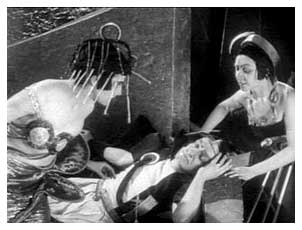
Russia had a long and strong tradition of Aesopic fiction in the nineteenth century because of Czarist censorship. Soviet censorship could be even more difficult to escape. As Ekaterina Khoklova notes, the Agitprop Dept. of the Communist Party Central Committee created in 1920 gave a political rating to every script and film. After 1923 “not a single film was released without a certificate of authorisation issued by Glavrepertkom, the State Repertoire Committee, and it was only with the permission of this committee that any alteration to an already completed film was possible” (91). The censors did not step in, but today we may ask if they missed two quite different Aesopian readings. First, the very possibility that workers could listen to Aelita’s claim to lead the revolution may suggest the fear that citizens of the Soviet Union could be tricked by a totalitarian leader claiming to represent the people. They are confused because the proper groundwork of cultural revolution had not been laid. Second, Aelita as claimant to the revolution may indicate the possibility of the triumph of the bourgeois classes within the Soviet state even after the revolution has supposedly triumphed. What if the New Economic Policy (NEP) is no more than the deluded dream of bourgeois intellectuals that a Marxist revolution can still be made with so many compromises toward capitalism and accommodation with the bourgeois past? Perhaps Protazanov’s film cannot think through either of these frightening possibilities. After all, the fantasy of Martian class warfare is never carried through to its end. Los awakens before it is over. The political unconscious of the film must be awakened before it reveals too much.
One difficulty of reading Aelita stems from the problems of trying to interpret any work of art under censorship and in an atmosphere of overheated class antagonisms. How does one know when to stop reading allegorically? A parallel situation is also posed in the other major Soviet film of 1924, Lev Kuleshov’s The Extraordinary Adventures of Mr. West in the Land of the Bolsheviks, released earlier in the year. On the surface level, the film demonstrates that Mr. West’s fears that the Bolsheviks are Cossack-like barbarians are unfounded. Mr. West is saved by the Soviet authorities from a con game run by criminals and aristocratic holdovers of the old regime. However, the arrival of the true Bolshevik, in a mise-en-scene that suggests the arrival of the secret police in the night, gives a very different plausible subtext to the film, one hardly flattering to the government.
Alexei Tolstoy, although he did not write the film script, which was the work of the playwright Aleksei Faiko and of Fyodor Otsep, worked with Protazanov on the adaptation (Stephan 73). It was in part being revised to avoid the negative criticism that the novel had received. Both Tolstoy and Protazanov hoped to succeed in overcoming their status as emigrés, that is, deserters of the cause, at that stage of their careers, and they needed to be seen as making overtures toward a new class consciousness. Although Tolstoy is not numbered among the “fellow travelers” in Leon Trotsky’s Literature and Revolution, (1922), he clearly fits into that category. Trotsky writes, “The proletariat also needs a continuity of creative tradition. At the present time the proletariat realizes this continuity not directly, but indirectly, through the creative bourgeois intelligentsia which gravitates towards the proletariat and which wants to keep warm under its wing” (227).
Aelita’s attempt to coopt the revolution may indicate the situation that develops without this continuity of creative tradition. On Mars, the proletariat has no assistance from the bourgeois intelligentsia. The Red Army man Gusev provokes the revolt, not the bourgeois intellectual Los. Of course this is all a dream, and the message of the film to ‘stop dreaming’ may imply, in Trotsky’s terms, to stop dreaming of an impossible revolution without bourgeois intellectuals in it just as much as it may suggest stop dreaming and build socialism in one country at this time. In short, the dream, the possibility that Mars may be seen as a stand-in for the Soviet Union, and the subversive allure of the Martian costume and set designs have all led to a multiplication of possible political readings of the film. Yet previous critics have failed to point out the extent to which the film is ambiguous and most likely strongly ambivalent on pressing Soviet issues.
Science fiction itself was a difficult genre to interpret, as Stalin was to recognise. It was a major outlet for speculation about Soviet society and its future before the Stalinist intellectual terror. Thus, although Aelita is generally seen as an unusual film for its time because of its science fiction genre, once we interpret it in the context of written science fiction, it looks much less sui generis. As Richard Stites notes, no science fiction utopian novels appeared in Russia after Yan Larri’s Land of the Happy in 1931 until after Stalin’s death (1989:177). Yet in the 1920s, as Stites shows, there was an enormous boom. Between 100–200 native works of science fiction came out in the 1920s, an unprecedented number in Russian publishing history although modest by Western standards. Only a few of these works came from the recognized writers—Tolstoy, Ehrenburg, Shklovsky, Kataev, and the dystopians, Zamyatin and Platonov (172). At least four books before the film version of Aelita were anti-Bolshevik: Zamyatin’s We (written in 1920 and reviewed in manuscript, but not published until the 1924 Gregory Zilboorg translation), Alexander Chayanov (Alexei Kremnev)’s Journey (1920), Apollon Karelin’s Russia in 1930 (1921), and Peter Krasnov’s Beyond the Thistle (1922). (See Stites 1989:184–89).
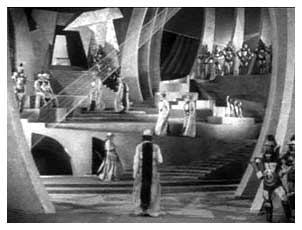
The boom in science fiction in the 1920s reflected the importance of technological advance to the Bolshevik agenda. Leland Fetzer [x] claims that science fiction began weakly in Russia in nineteenth century because of slow societal response to science, but much catching up was done in 1900–1917, and Alexei Tolstoy’s Aelita can as easily be seen as the last work of the turn of the century period as much as it is the first of the new period of the 1920s. It combines both a decadent world motif with a technological breakthrough motif. The idea of Russians going to Mars to annex it to the Soviet Union probably looked like a good gambit for a novel made to order for an exile’s return. Partially because many writers had emigrated, no great Russian novels were published after the Revolution until Boris Pilniak’s The Naked Year in 1922. The sponsorship of the returning emigré Tolstoy by Krasnaia Nov´ was an attempt to set an exemplary compromise between the radical avant-garde and the traditionalists for the literature of the future.
According to Halina Stephan, Tolstoi wrote Aelita with “an eye toward the official position on literature as well as the literary market. It was composed in close consultation with Gorky in Germany. Unfortunately for Tolstoy, the Futurists in the first issue of Lef in 1923 attacked the novel. They even began an anti-Tolstoy campaign that led to a formal alliance between Lef and the MAPP (Moscow Association of Proletarian Writers) in which they agreed that as long as Krasnaia Nov´ favoured Tolstoy they would resist efforts to organize Soviet literary life around that journal (71).
Without specifically mentioning Aelita’s rocky reception in 1922–1923, Vladimir Gakov in Soviet Literature’s 1983 100th birthday issue for Alexei Tolstoi, alludes to it thus: “Time has corrected the ideological confusion of Aelita, has smoothed it out, eradicated the superfluous, but the lyrical foundation remains untouched by the years” (165). Part of the ideological confusion was the element of theosophy in the novel, and even this element may have been prompted by Edgar Rice Burroughs. Richard A Lupoff (32–33) says that Burroughs was interested in Madame Blavatsky and theosophy. Furthermore, Tolstoy’s Mars is a decadent, dying world, and. Mars, where John Carter falls in love, is also a dying world in Burroughs’s first Mars novel, A Princess of Mars (1912) (Holtsmark 22). Other Burroughs novels that Tolstoy might have known are the next instalments in the series: The Gods of Mars (1913), The Warlord of Mars (1913), Thavia, Maid of Mars (1916), and The Chessman of Mars (1922). The series was enormously popular in Russian translation.
Although Tolstoy’s Aelita may look on the surface like a rather obvious adventure romance, at least two recent critics have praised the novel for its complexity and ambiguity—elements which Protazanov, working with Tolstoy, tried to maintain, even as the plot was drastically changed. For example, Jurij Striedter praises the novel as follows: “But Aleksei Tolstoy, as a novelist rooted in the tradition of the polyphonic socio-psychological realistic novel, constructed his Martian work in a polyphonic way, thereby creating a pattern of different voices and views complex enough to represent the controversial political and cultural context and not merely a utopian country beyond the clouds” (185). For Darko Suvin, the ambiguity of the ending “which sometimes strains the plot mechanics, makes also for a counterpointing richness, an encompassing of different attitudes and levels that envisages the practice as well as the necessity of an activist happiness. The novel raised extraterrestrial utopianism beyond pulp imitations of Verne, Wells, and Burroughs to a height not reached again until after Stalin’s death by Yefremov” (Suvin 261).
Along with Burroughs’s early Mars novels, probably the most relevant science fiction novel to an understanding of Aelita is Alexander Bogdanov’s Red Star because of its handling of the class and cultural dynamics of revolution. In Tolstoy’s novel much of the Martian civil authority seems to be invested in the Supreme Council of Engineers, and engineers have a similar role in Bogdanov’s novel. However, they seem to lack this collective power in Protazanov’s film. In Tolstoy’s novel, the workers are first led to a somewhat incoherent revolt by Gor, the engineer. Then Gusev, the Red Army man, directs their energies in a proper revolutionary way. Los joins this violent struggle, and he even rescues Gusev from enemy fire. In Protazanov’s film, there are no Martian leaders of the revolt. Gusev exhorts the faceless underground dwelling masses to rebellion. And Los is too much of a bourgeois weakling type to help him in the battle against the forces of Aelita’s father, Tuksib.
Nevertheless, Aelita as both novel and film promotes the classical Leninist idea that a change in the means of ownership of production will lead to a new society. By implication, a new culture will be the result of having the proletariat come to power. Bogdanov had ended his close support for Lenin soon after the 1905 Revolution, for he could see that Lenin did not subscribe to his conviction that a cultural revolution had to be achieved among the proletarians before a successful revolution could be waged. Thus Bogdanov cooperated with Maxim Gorky on his short-lived school for proletarian activists near Gorky’s home in Italy. Bogdanov’s emphasis on cultural revolution before political revolution is reflected in Red Star, the first Bolshevik utopian novel.
Readers of Bogdanov’s novel would recognize a certain amount of political chauvinism in Tolstoy’s Aelita and an even greater amount in Protazanov’s film. Protazanov’s Mars has absolutely nothing to teach Earth. Not only does it stand for the rule of the aristocracy, it does not look comfortable. The famous costumes and sets which may have been alluring to Soviet audiences in the 1920s really have only a stylistic novelty value rather than a value related to comfort or use. Engineer Gor in the film has a big telescope that can be used for watching Los on earth. If Soviet viewers did want to be on Mars, they were falling for empty glitz not the leisure life of the upper bourgeoisie.
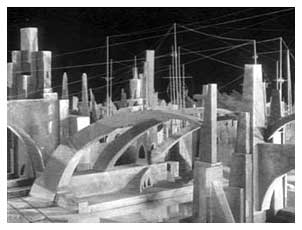
After the Bolshevik Revolution Red Star was reprinted at least five times before 1928 (Stites 1984:13), and the Proletcult did a stage adaptation in 1920. There were at least six editions of Engineer Menni, the sequel, actually on the plot level a prequel, between 1913 and 1923. In Bogdanov’s Red Star an engineer named Leonid is taken to Mars by a Martian Engineer named Menni. He finds that Mars has successfully weathered the changeover from capitalism to socialism. Unfortunately, Mars is running out of resources and needs to start a program of colonisation of either Earth or Venus. The Martians have already been debating whether they can expect Earth to take up socialism or whether they should recognize that Earth with its class antagonisms and nationalistic patriotisms is in every way unsuited for the rise of socialism. If the earth is unsuitable, the debate continues, should the inhabitants of Earth be wiped out?
Leonid is well received on Mars and he falls in love with an important member of the colonisation-study team named Netti, who turns out to be a woman. She is neither the exotic princess of Tolstoy’s novel nor the treacherous counterrevolutionary of Protazanov’s film but rather a worthy representative of a utopian future. She looks after Leonid even though he has antagonised Mars through his killing of Sterni, the chief advocate of the proposal to destroy Earth because of its backward state. She had vehemently opposed Sterni’s big speech, which Leonid finds in the Martian archive, even though it is off limits to him.
Sterni speculates that if Mars established a colony on Earth, Martians would be immediately embattled in an unresolvable war, which would destroy the kind of socialistic state that Mars advocated. In the council meeting he asked pointedly:
What would life be like for our comrades amid these dangers and eternal anxieties? Not only would all the joys of life be poisoned; the very form of life would soon be perverted and degraded. Little by little, life would be infiltrated by suspicion, mistrust, an egoistic thirst for self-preservation, and the cruelty which that instinct inevitably breeds. The colony would cease to be our colony and would become a militaristic republic in the midst of vanquished and invariably hostile peoples. Repeated attacks and the resultant casualties would not only generate feelings of revenge and hatred that would pervert the image of man so dear to us, but would also objectively force us to move from self-defence to a ruthless offensive. (112)
In the most accepted reading of the novel, Bogdanov’s own fears are voiced by Sterni. Loren R Graham feels that Bogdanov’s refusal to engage in revolutionary activity in 1917 and the Civil War period is an indication of his fears. Even if socialism begins to develop on Earth it will be perverted deeply and turn toward militarism because of its unfortunate environment (252). Certainly Russia’s huge number of peasants as compared to proletarian workers had hardly made it the ideal location for a revolution according to Marxist prediction. Richard Stites assents to this reading about the dangers of a premature revolution in a backward country (1984:5), as does Mark B Adams, who goes so far as to claim that Bogdanov predicted that the first socialist state on earth would be barbarous and chauvinistic—“An island in a hostile sea” (9). It is not surprising that in 1928 the year of Bogdanov’s death, a type of sacrificial suicide by blood transfusion, the novel was not reprinted. Its pessimism was too obvious.
However, Bogdanov’s novel is rich enough and polyphonic enough for other readings. Giovanni Miniscalco Basile feels that in Red Star Bogdanov is trying to show that Mars disturbs Leonid emotionally to the point of breakdown, he still has a bourgeois mindset that he has not overcome (62). In any event, Leonid is trying to build the socialist future and has been selected by the Martians to be taken to Mars because of his views. In contrast, Los in Tolstoy’s Aelita is just escaping from the grief over the death of his wife, as he himself admits (1981:24). Yet the Russian SFSR. has funded the trip, and the goal is to claim Mars, if it is inhabited, and unite Mars to Russia. In Protazanov’s film there is no clear political goal at all, and the trip does not seem to have any government funding.
In addition, Bogdanov’s sequel, Engineer Menni, was also ideologically suspect, and Protazanov may also be reacting to it as well. In telling how Mars developed socialism, Bogdanov here gives a very great role to engineers. This vision of progressive technocracy with the engineers as leaders, as Richard Stites points out (1984:14) in his preface to the novel, did not appear to give a significant enough role to the proletariat in building socialism.
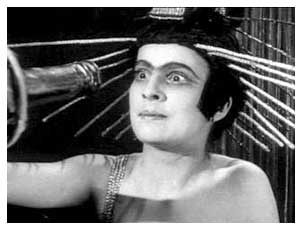
Kendall E Bailes in Technology and Society under Lenin and Stalin (1978) analyses in fine detail the Bolshevik suspicions toward bourgeois engineers during the 1920s. In 1921 the well-publicised Glavtop case occurred. In order to offset antispecialist feeling and prevent specialists from joining conspirational activities against the Soviet system, the authorities accused a group of specialists of counter-espionage. Former Nobel engineers were accused of receiving money to help restore the Swedish holdings in the Russian oil industry. The show trial was well publicised in Izvestia in July 22–23, 1922. Bailes notes that Lenin believed the accused to be guilty, but there was hardly any unanimity on this issue. In another case, in which a bourgeois engineer was hounded to suicide by hostile workers, Lenin took a more humane stance in speaking against such violence. (60–61). In 1928, four years after Lenin’s death, Stalin called for the show trial of the Shakthy conspirators, forty-three engineers and technicians accused of counterrevolutionary activities at the coal mines in the Ukraine (Graham 252). This event marked open class warfare against the engineers, as the cultural revolution from above was pressed forward. Bogdanov committed suicide through blood transfusion at this time.
Protazanov’s Aelita seems as suspicious of the aristocrats as it does of ineffectual bourgeois engineers. In Protazanov’s film, Aelita remains true to her class origins. The film suggests that your behaviour will run true to your class origins, whereas Tolstoy’s novel had suggested through Aelita that one could sympathise with another group, even if the motivation is grounded in romance. Thus the ‘once a ruler, always a ruler’ mentality of Protazanov’s film reflects the anti-bourgeois cultural trends of the mid-1920s. Not surprisingly, the villain of the film is a Nepman, who has killed off Los’s close friend Spiridonov, and who has tried to get Natasha interested in him. Natasha shows no interest in him, although Los thinks that she does.
In Tolstoy’s Aelita, there are no hints of women’s liberation on decadent Mars. Aelita’s protest against her father Tuksub is entirely a product of her having fallen in love with the Man from the Sky. The Red Army man Gusev leaves his girlfriend Masha without even telling her that he is going to Mars. He is taciturn not because she will not believe him but because he does not feel he needs to tell her.
The novel and film of Aelita appeared as the Zhenotdel, or Women’s Dept, created in 1919, was suffering cutbacks. According to Cathy Porter, by 1921, of 43 women originally working at the headquarters, only 23 remained. After Lenin’s stroke it was further cut and it was dissolved in 1930. Women from Zhenotdel performed the type of relief work with food distribution that we see Natasha doing in the film, although it is possible that she is working for some other government agency. According to Judith Mayne, after 1923 Zhenotdel was primarily justified as promoting the active participation of rural women in the construction of Soviet life (28–29).
In the film Natasha seems to be a sensible, hardworking woman engaged in the giant task of stabilising the country after Civil War. Why is she suddenly so willing to forgive her husband for trying to kill her at the end of the film? She is not shown going through any internal debate. She simply takes Los back, recognising that he had been jealous and mistaken. Two possible answers suggest themselves.
First, the film can be seen as setting an example for marriage partners to avoid divorce. According to Richard Stites in The Women’s Liberation Movement in Russia, the 1917 divorce reform was followed by a rash of divorces. By the economic stabilisation of 1922 the number of divorces was 122,479, but in the years 1924 to 1927 the number of divorces trebled. In Leningrad the number of divorces jumped from 5,536 in 1926 to 16,006 in 1927. In 1928 the ratio of divorces to marriages there was an amazingly high 4:5 (1978:370). Aelita appeared two years before the 1926 new Family Code recognized all marriages, legally registered or not (42–45). Yet such reforms did not stop the problem of a high divorce rate, which extended to the proletariat as well.
Second, Natasha’s unhesitating acceptance of her husband’s behaviour indicates an insensitivity toward women’s equality within the home. The only way that Natasha and Los can stay together as a couple is with Los accepting Natasha as a mother figure, for he certainly needs to be watched over. When he destroys his plans for travel to Mars at the end of the film, this conclusion may send out a message of ‘let’s get down to work’, but Los is really a case study for psychoanalysis, a practice that met tremendous resistance in the Soviet Union. Natasha accepts her psychotic husband as cured through repentance. In commenting on the setbacks of women’s liberation in Russia in the 1920s, Elizabeth Waters remarks:
For all that women’s rights were part of the Bolshevik program, they were also seen as a secondary matter, subordinate to the political and economical struggles of the (male) working class. Bolshevik Marxism viewed change first and foremost in terms of production: the worker and the factory took the centre of the revolutionary stage. By the same token domestic life was on the periphery: if home and family were transformed as a by-product of revolution, well and good; if not, there was no point in a special allocation of time and energy to their reform, as other issues took precedence (232).
Judith Mayne writes in Kino and the Woman Question (1989) that feminism suggested separatism to the Bolsheviks, “anathema not only because it jeopardised the principle of class solidarity above all, but because, in their view, feminism in Russia prior to the 1917 Revolution was right-wing” (28–29). Nevertheless, Mayne contends that “despite Marxism’s rather problematic relationship with the woman question, issues concerning women and sexual politics were … much a part of public debate and controversy” in the decade after the Revolution (29). Protazanov’s film witnesses to the fact that women’s issues were strongly debated even though the outcome was not a very triumphant one for women such as Natasha.
Twice in Aelita, we see on screen Aelita turning into Natasha before Los’s eyes. Is this a symbol that just as we must abandon our dreams of colonising Mars, we must abandon our erotic dreams of exotic, sexy lovers? In other words, does the vamp lose out to the wife? Yes, but this is only part of the issue. We must recognise the message that princesses can never be female comrades, and that female comrades married to intellectuals should also play the role of substitute mothers.
Editors note: Aelita, The Queen of Mars is available on DVD from Image Entertainment (www.image-entertainment.com) in a restored edition. Suggested retail price: $24.95.
Notes
1. The only extended analysis of Aelita since mine of 1983 appears in Richard Taylor’s collection of essays, Inside the Film Factory (1994). There may also be an analysis in a book it has not been possible to find in the US, Ian Christie and J Graffy’s collection from 1992, Yakov Protazanov; A Career in Russian Cinema. Denise Youngblood is apparently at work on a monograph on Protazanov.
Bibliography
Adams, Mark B, ‘Red Star: Another Look at Aleksandr Bogdanov’, Slavic Review 48.1 (Spring 1989): 3–15.
Bailes, Kendall E, Technology and Society under Lenin and Stalin: Origins of the Soviet Technical Intelligentsia, 1917–1941, Princeton: Princeton U P, 1978.
Basile, Giovanni Maniscalco. “The Utopia of Rebirth: Aleksandr Bogdanov’s Krasnaia Zvezda”, Canadian-American Slavic Studies 18.1–2 (Spring-Summer 1984): 54–62.
Bogdanov, Alexander, “Engineer Menni” Red Star: The First Bolshevik Utopia, eds Loren R Graham and Richard Stites, trans Charles Rougle, Bloomington: Indiana UP, 1984, 141–233.
– “Red Star” Red Star: The First Bolshevik Utopia, eds Loren R Graham and Richard Stites,Trans Charles Rougle, Bloomington: Indiana UP, 1984, 17–140.
Christensen, Peter G, “Aelita, Individual Psychology, and the Soviet State.” Holding the Vision: Essays on Film, ed Douglas Radcliff-Umstead. Kent, OH: International Film Society of Kent State University, 1983, 95–100.
Christie, Ian, “Canons and Careers: The Director in Soviet Cinema”, Stalinism and Soviet Cinema, eds Richard Taylor and Derek Spring, New York: Routledge, 1993, 142–70.
Christie, Ian, and J Graffy, eds, Yakov Protazanov: A Career in Russian Cinema, London, 1992.
Fetzer, Leland, ed and trans, “Introduction”, Pre-Revolutionary Russian Science Fiction: An Anthology, Ann Arbor: Ardis, 1982. [vii–xi].
Gakov, Vladimir, “Laser Ray in 1926: Alexei Tolstoy’s Science Fiction”, Soviet Literature No 418 (1983): 161–68.
Graham, Loren R, “Bogdanov’s Inner Message”, Red Star: The First Bolshevik Utopia, by Alexander Bogdanov, eds Loren R Graham and Richard Stites, trans, Charles Rougle, Bloomington: Indiana UP, 1984, 241–53.
–. “Bogdanov’s Red Star: An Early Bolshevik Science Utopia.” Nineteen Eighty-Four: Science between Utopia and Dystopia, eds Everett Mendelsohn and Helga Nowotny, Dordrecht: Reidel, 1984, 111–24.
Holtsmark, Erling B, Edgar Rice Burroughs, Boston: Twayne, 1986.
Kenez, Peter, Cinema and Soviet Society, 1917–1953, Cambridge: Cambridge UP, 1992.
Khoklova, Ekaterina, “Forbidden Films of the 1930s”, Stalinism and Soviet Cinema, eds Richard Tayor and Derek Spring, New York: Routledge, 1993, 90–96.
Leyda, Jay, Kino: A History of the Russian and Soviet Film, New York: Macmillan, 1960.
Lupoff, Richard A, Edgar Rice Burroughs: Master of Adventure, preface by Henry Hardin Heins, New York: Canaveral P, 1965.
Mayne, Judith, Kino and the Woman Question: Feminism and Soviet Silent Film, Columbus: Ohio UP, 1989.
Pipes, Richard, Russia under the Bolshevik Regime, New York: Vintage, 1995.
Porter, Cathy. Women in Revolutionary Russia, Cambridge: Cambridge UP, 1987.
Protazanov, Jakov, dir Aelita: Queen of Mars. Mezhrabpom-Rus, 1924, available on Kino International Red Silents: Visions of a Workers’ State Signature Series, 1991, 113 min.
Schmidt, Paul, “Constructivism and Film”, Soviet Union 3.2 (1976): 283–93.
Shlapentokh, Dmitry, and Vladimir Shlapentokh, Soviet Cinematography: Ideological Conflict and Social Reality, 1918–1991, New York: A De Gruyter, 1993.
Stephan, Halina, “Aleksei Tolstoi’s Aelita and the Inauguration of Soviet Science Fiction.” Canadian-American Slavic Studies, 18.1–2 (Spring-Summer 1984): 63–75.
Stites, Richard, “Fantasy and Revolution: Alexander Bogdanov and the Origins of Bolshevik Science Fiction”, Red Star: The First Bolshevik Utopia, by Alexander Bogdanov, eds Loren R Graham and Richard Stites, trans Charles Rougle, Bloomington: Indiana UP, 1984, 1–16.
– Revolutionary Dreams: Utopian Vision and Experimental Life in the Russian Revolution, Oxford: Oxford UP, 1989.
– The Women’s Liberation Movement in Russia: Feminism, Nihilism, and Bolshevism, 1860–1930, Princeton: Princeton UP, 1978.
Striedter, Jurij, “Three Postrevolutionary Russian Utopian Novels.” The Russian Novel from Pushkin to Pasternak, ed John Garrard, New Haven: Yale UP, 1983, 177–201.
Suvin, Darko, Metamorphoses of Science Fiction: On the Poetics and History of a Literary Genre, New Haven: Yale UP, 1979.
Taylor, Richard, The Politics of the Soviet Cinema, 1917–1929, Cambridge: Cambridge UP, 1979.
Taylor, Richard, and Ian Christie, eds Inside the Film Factory, New York: Routledge, 1994.
Thompson, Kristin, “Government Policies and Practical Necessities in the Soviet Cinema of the 1920s.” The Red Screen: Politics, Society and Art in Soviet Cinema, ed Anna Lawton, New York: Routledge, 1992, 19–41.
Tolstoy, Alexei N, Aelita, trans Antonia W Bouis, Introduction by Theodore Sturgeon. New York: Macmillan, 1981.
– “Aelita” Sobranie Sochinenii, 11 vols Moscow: Khudozhenestvennaia Literatura, 1958, 3: 535–685.
Trotsky, Leon, Literature and Revolution, trans Rose Strunsky, Ann Arbor: U of Michigan P, 1960.
Tsikounas, Myriam, Les Origines du cinéma soviétique: un regard neuf, preface by Pierre Sorlin, Paris: Cerf, 1992.
Vorontsov, Yuri, and Igor Rachuk, The Phenomenon of the Soviet Cinema, trans Doris Bradbury, Moscow: Progress P, 1980.
Walicki, Andrzej, “The Problem of the Socialist Intelligentsia.” The Russian Review 49.3 (July 1990): 293–304.
Waters, Elizabeth. “The Female Form in Soviet Political Iconography.” Russia’s Women: Accommodation, Resistance, Transformation, eds Barbara Evans Clements, Barbara Alpern Engel and Christine D Worobec, Berkeley: U of California P, 1991, 225–42.
Youngblood, Denise J, Movies for the Masses: Popular Cinema and Soviet Society in the 1920s, Cambridge: Cambridge UP, 1992.
– Soviet Cinema in the Silent Era, 1918–1935, Ann Arbor: UMI Research P, 1985.
Reprint permission granted by:
Dr Evgeny Pavlov
Senior Lecturer in Russian and German
School of Languages and Cultures
University of Canterbury
Private Bag 4800
Christchurch, New Zealand
ph. +64-3-366-7001, x8526
fax: +64-3-364-2522
Back to Topics
